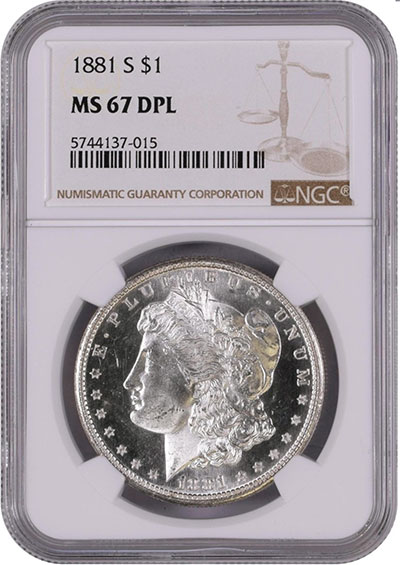Who is the fairest of them all? A strong argument can be made for a Prooflike Morgan Silver Dollar.
There are few numismatic delicacies as aesthetically appealing as a deeply Prooflike silver dollar. These coins are simply stunning. Anyone who collects Morgan Silver Dollars is familiar with these interesting coins. Even though most dates of Morgan Silver Dollars are known with Prooflike surfaces, collectors tend to treat them as a specialty category of the series. This is understandable, as collecting them can be much more difficult.
Prooflike coins are much rarer and cost considerably more than their frosty counterparts. There is also the sometimes subjective nature of whether a coin qualifies as Prooflike (PL) or the highly desirable Deep Prooflike (DPL). These interesting coins are well worth the time to explore more thoroughly.
First, let’s consider the rarity factor of Prooflike and Deep Prooflike Morgan Silver Dollars.
Since the inception of NGC over 30 years ago, the company has graded over 3,506,719 Morgan Silver Dollars in all grades. However, it has only graded 75,878 as Prooflike (about 2%) and just 28,464 coins as Deep Prooflike (less than 1%).
 This is for all dates and mintmarks. Also, just a few dates make up a large number of the coins designated as PL and DPL. As would be expected, many of these coins were struck from 1879 to 1882 at the San Francisco Mint. There are quite a few dates in which no examples are known in MS 65 with a PL or DPL designation. This includes known condition rarities such as the 1893-S and 1901. It also includes lesser rarities such as the 1904.
This is for all dates and mintmarks. Also, just a few dates make up a large number of the coins designated as PL and DPL. As would be expected, many of these coins were struck from 1879 to 1882 at the San Francisco Mint. There are quite a few dates in which no examples are known in MS 65 with a PL or DPL designation. This includes known condition rarities such as the 1893-S and 1901. It also includes lesser rarities such as the 1904.
Interestingly, one of the most common date Morgan Silver Dollars, the 1921 issue, is very rare in DPL. Only six coins have been certified as MS 65 DPL by NGC. One thing is perfectly clear — collecting Prooflike Morgan Silver Dollars by date is extremely challenging. As a side note, Peace Silver Dollars are virtually unknown with Prooflike surfaces. The design and method of manufacture did not yield coins with reflective surfaces.
Over the years I have been asked many times if I thought a Morgan Silver Dollar would qualify as PL or DPL. As mentioned above, this can sometimes be quite subjective. There is no test or exact rule of thumb to go by when considering a coin’s Prooflike designation.
Some old-timers go by the pencil test. They use a pencil to check for the reflection given by the coin’s surface. This can be useful, but sometimes difficult, especially if the coin has substantial toning. Collectors are urged to examine as many coins as possible to get an understanding of what qualifies as PL or DPL. If you are collecting coins by Type, a DPL Morgan Silver Dollar would be an excellent addition to your collection.
To get a fuller understanding of the rarity of this interesting specialty, the NGC Population Report is an invaluable tool. It will give you a snapshot of the rarity and number of coins possible to find when trying to purchase an example of a particular date. Price guides are also a good tool, but only for a rough estimate.
Many dates of Morgan Silver Dollars will far exceed expectations when offered at auction. Collectors who have chosen this particular field are extremely competitive when an interesting example shows up for sale. Check the auction records for past sales to get an understanding of the premiums some of these dates sell for. An extreme example is the abovementioned 1921 Morgan Silver Dollar. An MS 65 coin sells for around $150, while a DPL coin brings closer to $5,000.
Morgan Silver Dollars are not the only coins seen with Prooflike surfaces. For nearly two centuries, coins struck from freshly polished dies have been struck with reflective surfaces. These are usually quite scarce, and not collected as a subspecialty.
Some issues, such as Three Cent silvers and gold dollars, are seen with regularity displaying fully mirrored surfaces. The coins are sometimes so fully mirrored that even experts have a difficult time determining whether a coin was struck as Proof or is simply Prooflike. In the last decade, NGC has begun to designate any US coin as PL or DPL if the surfaces are reflective enough to qualify. There is a strong demand for US gold coins with these designations. Collectors are obviously drawn by the much lower population numbers for these interesting coins.
The most recent issue that has become extremely popular with Prooflike surfaces is the 2009 Ultra High Relief Double Eagle. The coins are beautifully designed and simply stunning with Prooflike surfaces. A small percentage of the coins certified have qualified as PL. Surprisingly, the extremely popular American Silver Eagles are almost never found with fully mirrored surfaces. It’s a shame the United States Mint does not produce American Silver Eagles with PL or DPL surfaces. These would undoubtedly be super popular.
The next time you attend a rare coin convention, examine as many coins with the PL or DPL designation as possible to gain a better understanding of this fascinating specialty. Be careful, however — you might get hooked.

